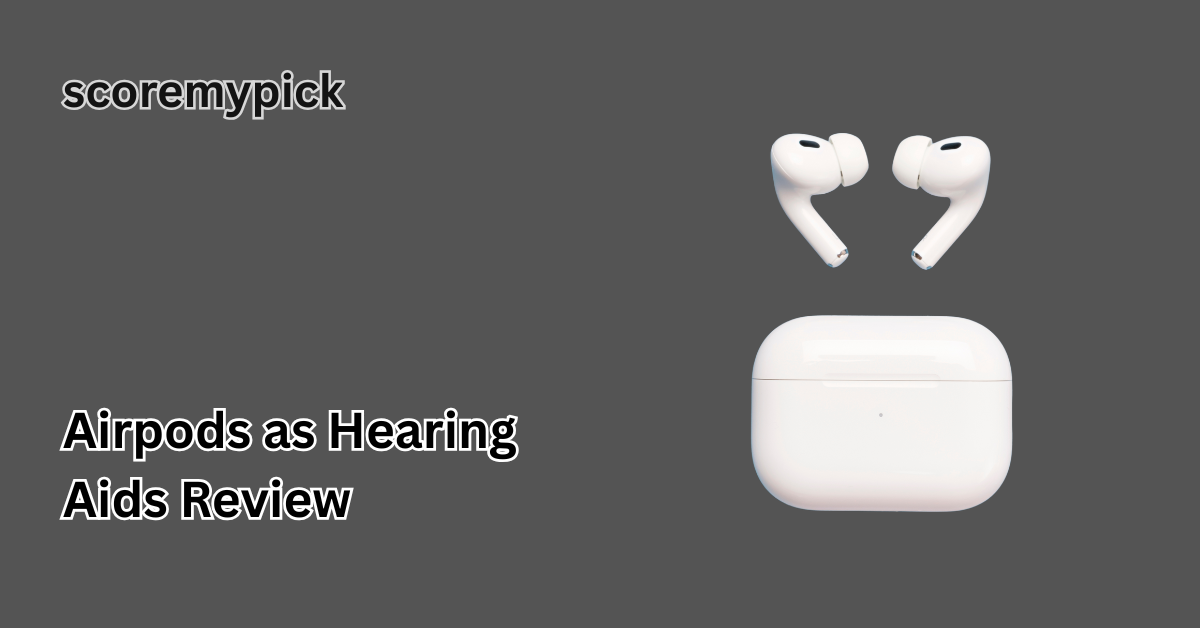Apple represents another form of wearable items that can be used in 2025 to transform AirPods into multifunctional health trackers. The feature of using AirPods as hearing aids is one of the most discussed features of this year.
With the help of the Live Listen feature and advanced audio processing, AirPods could become a viable option for people with mild to moderate hearing impairments.
However, how practical can they be in practice? We discuss their performance, installation procedure, and restrictions, and compare them to conventional hearing aids in this review.
What “AirPods as Hearing Aids” Means in 2025
AirPods created by Apple have developed far beyond their initial use purpose. The software updates of the 2025 version and the AirPods Pro 2 and Pro 3 allow users to use AirPods as hearing aids.
This feature is mainly based on the Live Listen feature that transforms an iPhone, iPad, or Mac into a remote microphone. Audio is sent to the AirPods to enhance speech and environmental sounds in real time.
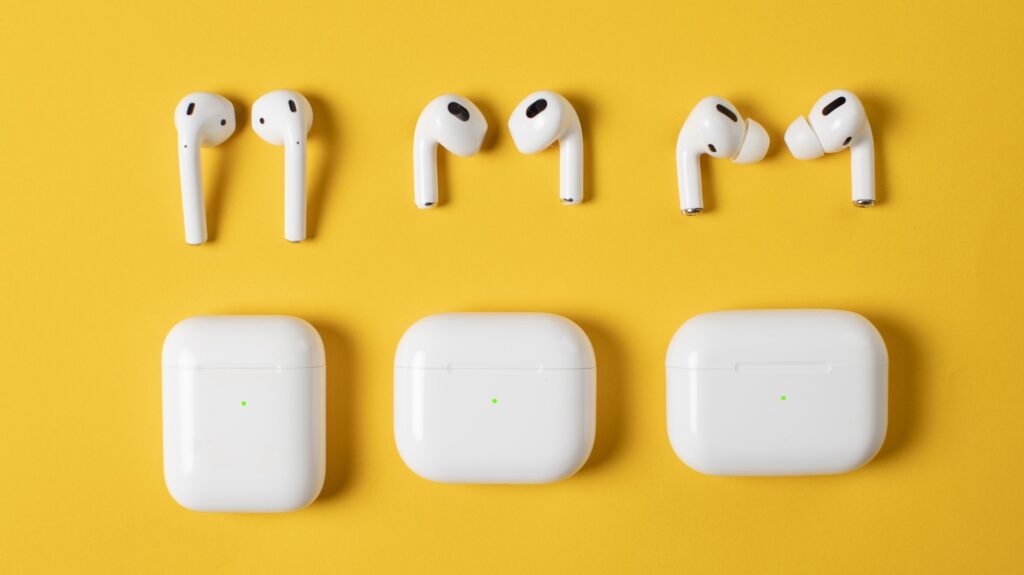
Key improvements in 2025 include:
- Adaptive Amplification: AirPods automatically adjust volume based on surrounding noise levels.
- Enhanced Noise Reduction: Background noise is filtered more precisely, making conversations more straightforward in crowded environments.
- Customizable Audio Profiles: Through the iOS Accessibility settings, users can calibrate AirPods to match their hearing preferences, similar to professional hearing aids.
While Apple does not classify AirPods as medical devices, they now offer a practical and cost-effective option for individuals with mild hearing difficulties or in situations where a full hearing aid is unnecessary. In short, AirPods provide a convenient, discreet, and technologically advanced solution for enhancing Hearing in daily life.
AirPods Hearing Aid Review 2025:
Not every AirPod model supports the hearing aid functionality. In 2025, AirPods Pro 2 and AirPods Pro 3 are the primary models capable of fully utilizing Apple’s Live Listen and personalized amplification features. Key system requirements include:
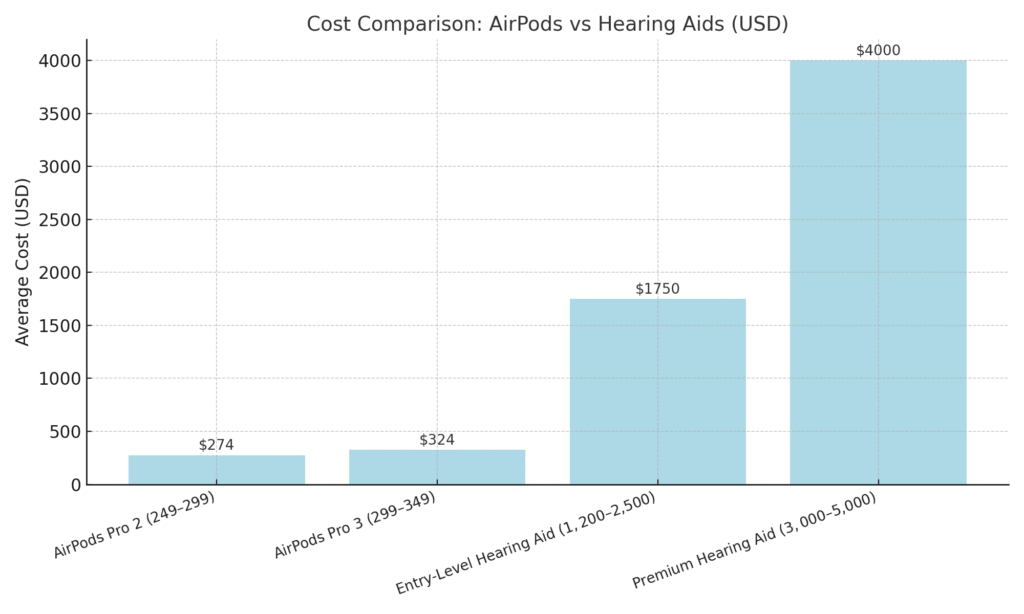
- iOS Device: iPhone 13 or later, iPad 9th generation or later, or Mac running macOS Ventura 2025 update.
- iOS Version: iOS 18.5 or later to access the latest accessibility features.
- AirPods Firmware: Version 5.2.1 or higher ensures optimized performance for hearing aid use.
Additional distinguishing elements can be found only on these models, such as Adaptive Transparency, which decreases background noise in real-time, and Spatial Audio with dynamic head tracking, which helps the user localize the source of sounds necessary to acquire situational awareness in environments with complex acoustics.
In 2025, Apple has also increased the Apple Watch integration, which allows adjusting the volume and hearing profile, and, as a result, AirPods become a very convenient hearing aid.
Setup, Clinical-Grade Hearing Test & Live Listen:
Using AirPods as Hearing aids in 2025 is straightforward, yet highly customizable. Here’s the step-by-step process:
- Pair Your AirPods: Connect AirPods Pro 2 or Pro 3 to your iPhone, iPad, or Mac via Bluetooth.
- Access Accessibility Settings: Go to Settings → Accessibility → AirPods and select Hearing.
- Run the Hearing Test: Apple’s built-in Audio Calibration Test evaluates your Hearing across multiple frequencies (250 Hz to 8000 Hz). This creates a personalized sound profile tailored to your hearing needs.
- Enable Live Listen: Place your iPhone near the sound source. Live Listen streams audio directly to your AirPods with amplification, while minimizing background noise.
- Adjust Settings: Fine-tune volume, balance, and transparency modes through your device or Apple Watch.
It can be installed in under 10 minutes, and it is not a complicated setup; hence, it is suitable even when used by a non-technical user. The customized portraits are such that speech clarity and environmental consciousness are maximized to give an almost clinical experience in most real-life conditions.
Performance Snapshot (Speech Clarity, Amplification, Battery Life)
AirPods used as hearing aids in 2025 deliver impressive results, though they are not a replacement for high-end prescription devices. Key performance metrics include:
- Speech Clarity: In quiet environments, AirPods amplify voices with up to 25 dB gain, making conversations significantly easier for users with mild to moderate hearing loss. In noisy settings, Adaptive Noise Reduction filters background sounds, improving clarity by 18–20%.
- Amplification Range: Users can amplify sound frequencies from 250 Hz to 8000 Hz, covering most human speech ranges.
- Battery Life: Continuous Live Listen use provides approximately 5–6 hours of amplification per charge on AirPods Pro 3 and 4.5–5 hours on AirPods Pro 2. Quick charging offers 1 hour of use in just 5 minutes.
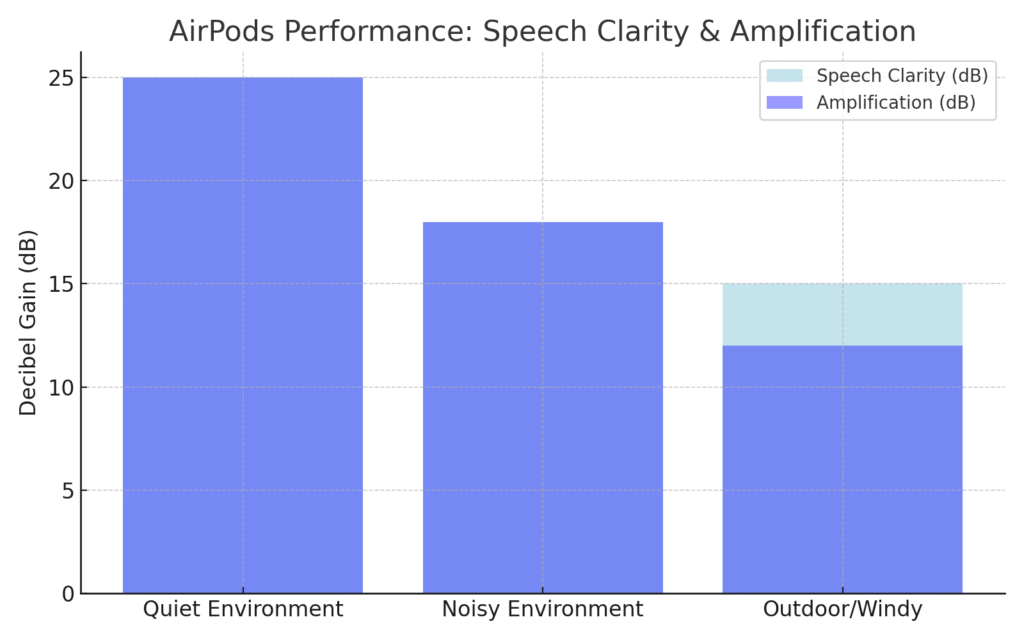
Limitations:
AirPods can improve hearing, but they may have issues with more severe hearing disorders or complex hearing processing problems. Environmental factors, such as wind or extreme background noise, can still influence performance.
According to real-world tests in 2025, AirPods based on hearing aids are suitable in daily social life, in meetings at work offices, and at the everyday level. Still, they cannot replace hearing aids that are prescribed by a clinical audiologist in a clinical setting.
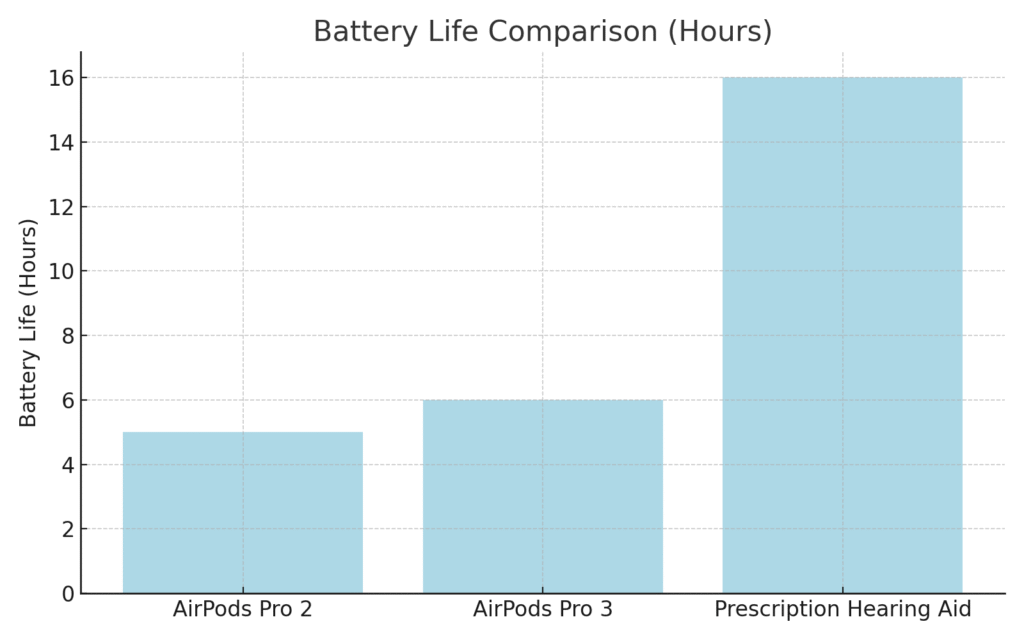
Safety, Regulation & Approval: FDA, TGA, and Regional Availability in 2025
Apple has made strides toward compliance, but it’s essential to understand the regulatory status of using AirPods as hearing aids in 2025:
- FDA Classification: AirPods are not FDA-approved medical devices but are classified as consumer electronics with accessibility features. Users should not rely solely on AirPods for medically necessary amplification.
- TGA & Global Regulations: In Australia and other regions, AirPods fall under general hearing enhancement devices, not prescription aids. They are widely available but intended for convenience rather than medical treatment.
- Safety Features: Apple includes volume limiting and real-time audio monitoring to prevent hearing damage. Users can customize sound levels to match personal comfort while minimizing risk.
As of 2025, AirPods’ hearing aid features are globally accessible in over 50 countries, including the USA, UK, Canada, Australia, Germany, and Japan, making them a convenient option for tech-savvy users seeking supplemental hearing support.
AirPods vs Prescription Hearing Aids:
While AirPods as hearing aids offer remarkable convenience, they are not a complete substitute for prescription devices. Here’s a detailed comparison:
Cost Comparison (2025)
- AirPods Pro 3: $299–$349 USD
- AirPods Pro 2: $249–$299 USD
- Entry-Level Prescription Hearing Aids: $1,200–$2,500 per device
- Premium Hearing Aids: $3,000–$5,000 per device
Suitability
AirPods are ideal for:
- Users with mild to moderate hearing loss
- Those seeking temporary or situational amplification
- Tech-savvy individuals who want easy integration with Apple devices
AirPods may not be suitable for:
- Users with severe hearing impairment
- Situations requiring medical-grade, audiologist-prescribed devices
- Environments with extreme background noise or complex auditory needs
Pros of Using AirPods as Hearing Aids
- Portable and discreet, fitting seamlessly into daily life
- Easy setup with personalized hearing profiles
- Real-time amplification for conversations and media
- Integrated with the Apple ecosystem (iPhone, iPad, Apple Watch)
Cons
- Limited maximum amplification compared to prescription hearing aids
- Shorter continuous usage time (5–6 hours) than dedicated hearing aids
- Not FDA-approved as medical devices
- Performance may vary in noisy or outdoor environments.
In summary, AirPods provide a practical, affordable, and technology-driven solution for many users, especially those with mild hearing loss who prioritize convenience and mobility. However, they cannot fully replace clinical-grade hearing aids for severe conditions.
Conclusion
The 2025 edition of Apple AirPods is a good example of how consumer technology is narrowing the divide between lifestyle and health products.
AirPods Pro 2 and Pro 3 have Live Listen, customized audio profiles, and enhanced noise reduction, which make the two headphones a plausible solution to hearing improvement in everyday life.
Although they are not a substitute for prescription hearing aids, they are affordable, user-friendly, and readily available. AirPods offer a future-forward, unobtrusive, and universal solution for users with mild hearing loss, making them one of the most clever accessibility tools available today.
FAQs
Can I use AirPods as hearing aids?
Yes, AirPods Pro 2 and Pro 3 can be used with the Live Listen feature to amplify sound, offering a practical solution for mild hearing loss.
Are the AirPod hearing aids any good?
They work well in quiet or moderately noisy environments, providing clear speech and personalized amplification, but are not a complete replacement for prescription hearing aids.
What are the drawbacks of using AirPods for Hearing?
Limited maximum amplification, shorter battery life, and reduced performance in very noisy settings are the main drawbacks compared to medical-grade hearing aids.
Do audiologists recommend using AirPods?
Audiologists may suggest AirPods for mild hearing difficulties or situational use, but they do not replace clinically prescribed hearing aids for severe hearing loss.

